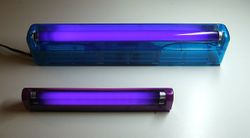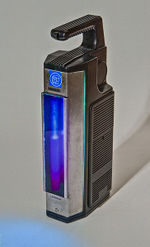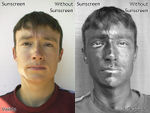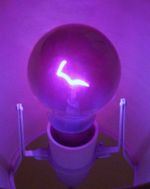Black light
Back light is light from the electromagnetic spectrum known as ultraviolet light (UV). Ultraviolet light has shorter wavelengths then visible light that the eye can see. Today, scientists have categorized UV light into three separate categories; the near ultraviolet, the far ultraviolet, and the extreme ultraviolet. Near UV light is the closest light that is visible to the naked eye. The far UV light falls between the near and the extreme and is the least explored out of all the categories. The last is extreme UV light which is closest to X-rays and is the most energetic out of all three types.
When the sun is shining outside, humans are exposed to a massive amount of sunlight. The sun creates ultraviolet waves, which is the cause of sunburns. It is extremely important to protect our skin from these waves, especially if one is exposed to it for long periods of time. Although some of the UV light given off by the sun is blocked by the earth’s atmosphere, it always finds a way to sneak through and cause damage to people’s skin. Not only are scientist studying UV light on the ground, but in space as well. Satellites help them study the astronomy of UV light.[1]
Uses
Black light is used in order to see and read phosphors. A phosphor is a synthetic fluorescent or phosphorescent substance, especially any of those used to coat the screens of cathode ray tubes. Not all of these phosphors, however, are man-made, some are natural. For example there are lots of little natural phosphors in your teeth and fingernails. Man-made phosphors include things such as television screens, some paints, fabrics, and plastics. Also in everyday items that we use, like highlighters you use in school and in the fun glow in the dark products you find in the kid section of the store. Many amusement parks and clubs use a special specific kind of black light that glows in different colors for the fun of it. In the United States today, you can also buy fluorescent black light bubbles, invisible black light ink, fluorescent black light carpet, and even hair gel. These cool products that use black light have been just recently discovered and many new discoveries are being made as the decades go on.
People use black light in their everyday jobs, such as a repairman. They use it to find invisible leaks in machinery and even inject a little florescent dye into a fuel sample, which will be illuminated by the black light. People use black light all for a similar reason, to make the invisible visible for the eye to see. [2].
Types of Black Light
Fluorescent light is commonly used to illuminate offices and has much more complicated light emission mechanism that incandescent light. Inside florescent lamps, ultraviolet rays are created and are transformed into visible light that we can see with the naked eye. The “exited state” and the “ground state” of electrons plays a very important role when the electrical discharge phenomena comes to play. A standard fluorescent lamp is a slender glass tube coated with fluorescent material on the inside surface. When mercury vapor is injected inside the electrons are attracted at both ends of the tube. When the voltage comes into view what you are seeing is the heated up electrons that flow towards the positive electrode. And these electrons create ultraviolet light.
Incandescent light is seen as a yellowish color, compared to fluorescent ultraviolet light. The light turns this color because this kind of light produces heat. The filament, inside the lamp is what heats up. These filaments are made out of double coils of tungsten, a very high electrical resistance metal. When the tungsten heats up to a very high heat, it doesn’t burn. This is because gas is injected into the incandescent bulbs to eliminate all the oxygen.[3]
Safety
Ultraviolet light are used in University laboratories and also in some hospital care rooms. They are used in biological safety cabinets, light boxes, and cross linkers. Although UV light has accommodating uses, it also has harmful outcomes. One of the problems with using UV light is that symptoms of overexposure damage is felt right away but the physical destruction takes some time to develop. The victim does not know or feel the effects until after the damage is done and they are completely exposed. The lowest amount of exposure leads the damage of the cataracts and medium exposure leads to skin and eye burns. In extreme cases ultimate exposure leads to having a higher risk of some types of skin cancer.
It is extremely important to stay away from hazardous ultraviolet source areas. Do no enter a room when UV lights are on. Anyone who has been sunburns has felt some sort of UV light burns. Light sunburns can be taken care of fairly easily, but if a person has a continuous amount of exposure, skin cancer is a risk. Eyes are also very important to protect from UV light damage. Since light can enter at all angles into the eye, the cornea is always exposed. The lens can also be damaged so it is very important to wear eye protection. Normal eyeglass or contacts will only offer a little amount of protection from UV lights. Protecting the skin can be easily done by wearing a simple long-sleeved shirt or by applying sunscreen on a regular basis.[4]
How they work
Back Lights are often seen at amusement parks, science museums, and are used in Halloween displays. UV light is not like any other type of light. They have the ability to make white teeth, clothes, and various other things glow in the dark. A black light bulb is purple, which you can see with your naked eye. Although we cannot see the ultraviolet light that is being produced because our eyes can only see visible light. What we are seeing on a fluorescent poster or invisible hand stamp are called phosphors. Phosphors are any substance that emits visible light in response to some sort of radiation. These phosphors have the ability to covert the energy in the UV radiation from black light onto visible light. Phosphors, substances that give off light are also called fluoresce; give off light when they are exposed to light. When a photon hits a phosphor atom, one of the original phosphor electrons jumps to a higher energy level. This causes the atom to vibrate, producing heat. Eventually the electron falls back to its original level and releases energy in the form of another photon. Emitted UV lights react with various external phosphors.[5]
Video
Video description here....
References
- ↑ Netting, Ruth. Ultraviolet Waves. NASA. Web. 4-15-14.
- ↑ Harris, Tom. Black Light Uses. “How Black Lights Work”. Web. 3-31-14.
- ↑ INC, Canon. What is light. “Canon Global”. Web. 3-31-14.
- ↑ Washington, University. Hazards of Ultraviolet Light. “ehs”. Web. 4-14-14.
- ↑ Channel, Discovery. howstuffworks. “How Black Lights Work”. Web. 4-15-14.
| ||||||||||||||




